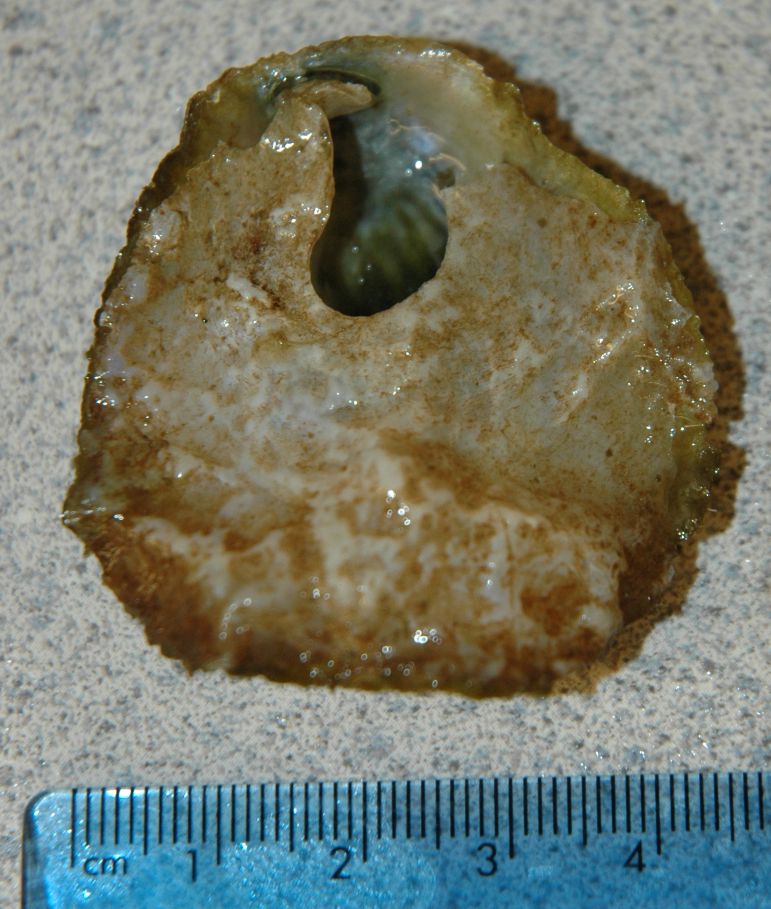Pododesmus macroschisma (Gray, 1850)Common name(s): Alaska falsejingle, Jingle shell, Money shell, Pearly monia, Rock oyster, Abalone jingle, Green false-jingle, Blister shell, False Pacific jingle shell |
||
| Synonyms: Pododesmus macrochisma, Pododesmus cepio, Monia machroschisma |  |
 |
| Phylum Mollusca
Class Bivalvia Subclass Pteriomorphia Order Ostreoida Suborder Pectinina Family Anomiidae |
||
| Pododesmus macroschisma shell, with the top (left) valve on left and bottom (right) valve on right. | ||
| (Photo by: Dave Cowles, August 2005) | ||
How to Distinguish from Similar Species: There is no other local species similar to this. Oysters cement one shell to the substrate but they are much larger, have thick shells, and do not have the hole in the shell through which a byssus attaches. The rock scallop Hinnites gigantea is larger, has a thicker shell with no hole in it, and has a deep purple stain on the inside of the shell near the hinge.
Geographical Range: Bering Sea, Alaska to Baja California; Chukchi Sea
Depth Range: Low intertidal to 90 m
Habitat: Cemented to rocks, plastic, or wood. Common on pilings
Biology/Natural History: Predators include the seastars Evasterias troschelii and Orthasterias koehleri. Dead shells of this species are often colonized by boring sponges such as Cliona celata var californiana.
The name "jingle shell" comes from the fact that the dead shells make a pleasant jingling sound when struck together. People often make mobile chimes from them, using the handy byssal hole to hang them.
Pododesmus macrochisma is now an Alaskan species, different from this species.
| Return to: | |||
| Main Page | Alphabetic Index | Systematic Index | Glossary |
References:
Dichotomous Keys:Flora and Fairbanks, 1966
Kozloff 1987, 1996 (As Pododesmus cepio)
Smith and Carlton, 1975 (As Pododesmus cepio)
General References:
Gotshall,
1994 (as Pododesmus cepio)
Gotshall
and Laurent, 1979 (as Pododesmus cepio)
Hinton,
1987 (as Pododesmus cepio)
Johnson
and Snook, 1955
Kozloff,
1993 (as Pododesmus cepio)
McConnaughey
and McConnaughey, 1985
Niesen,
1994 (As Pododesmus cepio)
Niesen,
1997 (As Pododesmus cepio)
O'Clair
and O'Clair, 1998
Ricketts
et al., 1985 (As Pododesmus cepio)
Sept,
1999
Scientific
Articles:
Web sites:
General Notes and Observations: Locations, abundances, unusual behaviors:
These are very common shells attached to subtidal rocks
near
Northwest
Island and Coffin Rocks.

This live specimen shows the living tissue inside

Here is a view of the right valve, with the byssus where it attaches
to the rock

Here is a whole live specimen, encrusted with barnacles and bryozoans.
Authors and Editors of Page:
Dave Cowles (2005): Created original page